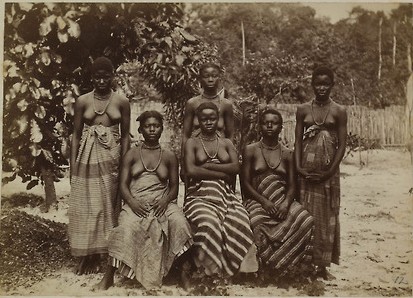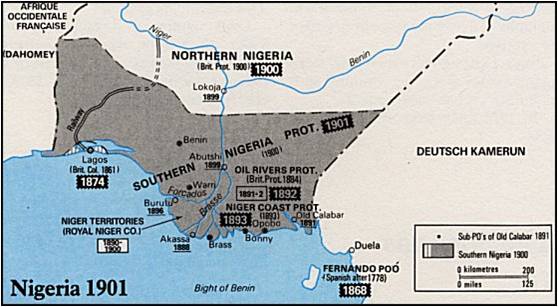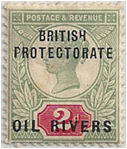ALBUM – View my Oil Rivers Protectorate album
TRANSITION CHART for the British Nigeria area
Fast Facts
Region: West Africa
Group: British Nigeria
Classification: Colony (British)
Prior Regime: Opobo State
Key Dates:
1862, January 1 – Lagos Island is annexed as a colony of Britain
1885 – Nigeria territory confirmed at the Conference of Berlin
1885 – Oil Rivers Protectorate proclaimed by the British after they had defeated King Jaja of Opobo
1893, May 12 – Oil Rivers Protectorate expanded and renamed Niger Coast Protectorate
1900, Jan 1 – Southern Nigeria Protectorate formed by joining Niger Coast Protectorate with territories from the Royal Niger Company
1906 – Lagos became part of Southern Nigeria
1914, Jan 1 – Southern Nigeria and Northern Nigeria were combined to form the colony of Nigeria
Following Regime: Niger Coast Protectorate
Scott Catalogue: (Niger Coast Protectorate) #1-6
Pick Catalogue: none
History

As the Germans began to flex their colonial muscles by annexing Togoland and Cameroon, the British and the French realized that decisive action was required before they started losing their territory. Therefore, a major Conference in Berlin was held in 1885 where the major European powers carved up Africa for colonization, thus, with the exception of Ethiopia and Liberia, all of Africa was to be ruled by the Europeans. In this agreement, Britain was given the area of Nigeria.
After the Berlin Conference, Britain formalized the Oil Rivers Protectorate, which included the Niger Delta and extended eastward to Calabar, where the British consulate general was relocated from Fernando Po. The primary purpose was to control trade coming down the Niger River. As a protectorate, the new territory didn’t have the full status of a colony, but remained under the jurisdiction of the Foreign Office.
The expansion into the territory was a series of diplomatic treaties and bloody battles, which ultimately subdued most of the local tribes. In August 1891, the British Government established a Consular Administration over the Oil Rivers Protectorate, consisting of six consular river districts.
 In 1893 the territory was renamed Niger Coast Protectorate, and expanded to include the region from Old Calabar to Lagos Colony and Protectorate, and northward up the Niger River as far as Lokoja, the headquarters of the Royal Niger Company.
In 1893 the territory was renamed Niger Coast Protectorate, and expanded to include the region from Old Calabar to Lagos Colony and Protectorate, and northward up the Niger River as far as Lokoja, the headquarters of the Royal Niger Company.
As development proceeded in Nigeria, it soon became obvious that the practice of managing territories through chartered companies could no longer compete with the Government run colonies of the French or Germans. Therefore, the Britain canceled the charter for the Royal Niger Company for the sum of £865,000 and rights to half the mining revenue for 99 years. On 1 Jan 1900, the territories of the Niger basin were transferred to the British government and the Protectorates of Northern Nigeria and Southern Nigeria were formed.
Stamps
 ALBUM
ALBUM
The main post office was established at Calabar in November 1891 and sub-offices were developed at Benin, Bonny, Brass, Opobo, and Warri. Initially postage stamps of Great Britain were used, but in July 1892, 6 British stamps were overprinted “BRITISH / PROTECTORATE / OIL / RIVERS” and issued. In September 1893, there was an urgent need for halfpenny values which resulted in a variety of surcharges on 2d and 2-1/2d stamps. While most simply read “HALF / PENNY”, with a horizontal bar to obliterate the old value, some were overprinted “1/2 d” twice, with the intent that they be bisected diagonally to produce two 1/2d stamps.
As the transition to Niger Coast Protectorate was occurring, new stamps were being prepared. Therefore, the first issue for the Niger Coast Protectorate which featured a 3/4 portrait of Queen Victoria, has the inscription “OIL RIVERS” obliterated and was overprinted “NIGER COAST”. Theses stamps were made available in November 1893, but were superseded in May 1894 by stamps of a new design with the correct inscription.
Banknotes
British currency was used
Links
Colonial Nigeria from Wikipedia
The Origin of Sapele Township from the Journal of the Historical Society of Nigeria
Stamps of Colonial Nigeria at Stamp Collecting Blog
Oil Rivers Protectorate Stamps – GB Overprints Society





I have a complete set of British Protectorate overprint on Oil Rivers Queen Victoria era, used,may I know the value of it,thanks
Hi Desmond
Welcome to DCStamps
I don’t normally give out values, primarily because everything depends on condition. I would suggest you reach out to a local stamp club, or a local dealer, and they could give you a better view by actually seeing the stamps.
Good luck
Michael